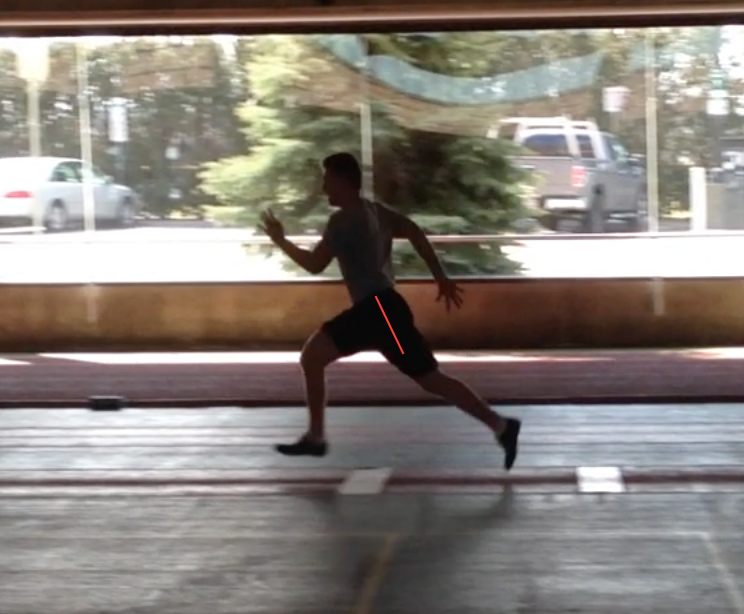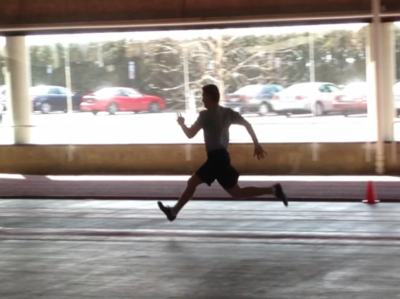I used to tell people that long jump wasn’t the most coachable of events. It was about being fast and reactive, and becoming faster and more reactive, to jump further. Those things are certainly true, but as it is across the events, there is a dance between details and development. What follows is a case study of a high school long jumper between his sophomore year, when he was a 21 foot jumper from 16 steps, and the end of his senior year where he jumped 23’5″ from a 16 step approach. First we’ll compare two short approach jumps then progress to a discussion of the developmental and event-specific details involved in progressing him as an athlete and a jumper.
I included full speed and slow motion clips in the video above as it’s easier to see overall speed, flow, and rhythm in real time and the exact nature of foot strikes in slow motion. As you can probably tell there are some big changes between the two jumps. General approach posture, speed, and sprinting technique improved dramatically between 2013 and 2015. There are also very big differences in foot strikes during the approach.
Technical Comparison – Approach and the last 4 steps
In the full speed video of the 2013 10-step, you’ll notice a disruption in rhythm 3-4 steps out and general slowing. As Boo Schexnayder often suggests, looking at what precedes the mistake is often where to find the cause. In a long jump approach you should see pushing and rising that rhythmically ascends to the vertical orientation needed for takeoff. In the 2013 jump the athlete is excessively pushing out the back in his sprinting with an anteriorly rotated pelvis that isn’t progressively rising in the approach.

(Figure 1) After toe off of 5th to last step in 2013-Foot was on the ground well behind the body and the pelvis is out of step with trunk posture
Putting the feet out in front from the position displayed above in Figure 1 is a common strategy I’ve seen high school athletes use. It’s akin to a stumble reflex for long jump – the athlete senses they aren’t in an appropriate posture to take off at that speed and thus puts the foot out in front of the body. These abruptly more vertical or obtuse foot strikes bring the body and pelvis upright (leaning it back from the anteriorly rotated position) while also bringing the athlete to a more frontside orientation needed for takeoff. The obvious issue is the large sacrifice in horizontal velocity with these blocked or braking steps, altered recoveries for the succeeding steps, and the undue tissue forces that these strikes cause.
4th to Last Step
By the 4th to last step in 2013 you’ll see this stumble reflex strategy in action with an out in front heel first strike and the pelvis in a butt-out or excessively anterior rotated orientation. Comparatively, in the 2015 8-step approach the athlete could be a little more upright at this point (he is trying to over-speed the shorter approach a bit), but the strikes are good, hips are aligned, and the posture is progressing smoothly through the approach.
3rd to Last Step

(Figure 3) 3rd to last step
Although both of these pictures are a frame early for the 3rd to last step, you’ll see the foot strike in 2013 is even further in front of the body than the step preceding it. The athlete is using blocked or braking steps to achieve the vertical orientation needed for takeoff vs being able to put his feet underneath him and sprint to this position. Meanwhile, in the 2015 8-step the shin and body continue to progress to a more vertical orientation. Ideally the athlete would be a smidgen more upright by this point in 2015. Even in a short approach long jump shin angles and overall posture should progress to a relatively vertical orientation by the last 3-4 steps. This helps build takeoff skills that can be carried over to longer approaches where the jumper will already be upright by this point of the approach.
Penultimate Step Preparation
The flight off of the 3rd to last step in 2013 displays an almost scissor-legged position with an extreme angle of the penultimate foot to the ground. Successfully striking and rolling through the foot from this position that doesn’t match the rest of the run is nearly impossible at high speeds. The considerable slowing coming into, and off of, this step makes further sense with this odd penultimate step paradigm. Going back to the slow motion clips, you’ll notice more congruency in flight between the preceding steps and the penultimate in the 2015 short approach.
Penultimate Step (2nd/Next to Last Step)
Comparing the penultimate steps above, there is more frontside distance in 2013 while the foot begins to interact with the ground much more underneath him in 2015. Looking back at the video you’ll also note that the foot strikes the ground in a extreme heel first orientation in 2013 with much more of a rolling contact in 2015. We want the penultimate step to roll heel-to-toe, not ground on the heel and then have the toe slam down causing a large loss in horizontal velocity.
Plant and Takeoff
The plants for takeoff don’t produce incredibly dissimilar still pictures, despite the fact that the loss of speed coming into the plant in 2013 is significant. In the takeoff pictures above, the free leg quickly swings out in front in 2013 with a small archetype of that still remaining in 2015. This scissoring action of the legs in 2013 mirrors what you see two steps previously in the flight phase coming onto the penultimate (this can be seen in the picture of the flight/air phase off the 3rd to last step that can be found in Figure 4). As Boo has very astutely pointed out, actions and steps often correspond to what happened when the limbs were in the same positions two steps before.
Details of Development
So in the 2013 short approach jump you have an athlete that is struggling to control the pelvis, pushing out the back, and putting his feet out in front of him in the last few steps of the approach. He also has an odd penultimate action and a scissoring free leg at takeoff. How do you correct the above items? Do you just simply cue each of the above? Do you work developmentally to build general skills and bring up deficiencies, waiting until those are in place before correcting the event actions? As is often the case, I think it’s a bit of both and you should work in parallel-stream (credit to coaching friend Daniel Martinez for the term); bringing up general development while also coaxing event technique to levels that current development supports.
In part 2 we’ll begin to explore the general and event specific details that helped produce the changes you see on the runway between 2013 and 2015.
FOLLOW US FOR MORE -
SHARING IS CARING -








Speak Your Mind